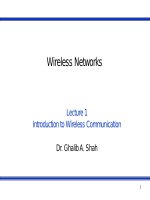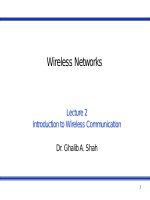Wireless networks - Lecture 22: WCDMA (Part 2)
Bạn đang xem bản rút gọn của tài liệu. Xem và tải ngay bản đầy đủ của tài liệu tại đây (516.25 KB, 24 trang )
Wireless Networks
Lecture 22
WCDMA (Part II)
Dr. Ghalib A. Shah
1
Outlines
Last Lecture Review
Spreading and Scrambling
Transport Channels
Physical Channels
► UL Dedicated
Signalling
Physical Layer Procedures
► RACH Operation
► Cell Searching
► Power Control
•
•
Open Fast loop
Closed Loop
2
Last Lecture Review
Last Lecture review
UMTS
Service Classes in UMTS
UTRAN Architecture
Radio Interface protocol Architecture
Protocol Models for UTRAN
Logical Channels
3
Air interface parameters
Carrier Spacing
5 MHz (nominal)
Chip Rate
3.84 Mcps
Frame Length
10 ms (38400 chips)
No. of slots / frame
15
No. of chips / slot
2560 chips (Max. 2560 bits)
Uplink SF
4 to 256
Downlink SF
4 to 512
Channel Rate
7.5 Kbps to 960 Kbps
4
Spreading and Scrambling
Spreading means increasing the signal bandwidth
Strictly speaking, spreading includes two operations:
► Channelization (increases signal bandwidth) - using orthogonal
codes
► Scrambling (does not affect the signal bandwidth) - using
pseudo noise
5
Channelization
Channelisation codes are orthogonal codes, based on
Orthogonal Variable Spreading Factor (OVSF)
technique
The codes are fully orthogonal, i.e., they do not
interfere with each other, only if the codes are time
synchronized
Thus, channelization codes can separate the
transmissions from a single source
In the downlink, it can separate different users within
one cell/sector
Limited orthogonal codes must be reused in every cell
► Problem: Interference if two cells use the same code
► Solution: Scrambling codes to reduce inter-base-station
6
interference
It is possible that two mobiles are using the
same codes.
In order to separate different users in the
uplink, scrambling codes are used.
One code tree is used with one scrambling
code on top of the tree.
7
Channelization
8
Scrambling
In the scrambling process the code sequence is
multiplied with a pseudorandom scrambling code.
The scrambling code can be a long code (a Gold code
with 10 ms period) or a short code (S(2) code).
In the downlink scrambling codes are used to reduce
the inter-basestation interference. Typically, each Node
B has only one scrambling code for UEs to separate
base stations. Since a code tree under one scrambling
code is used by all users in its cell, proper code
management is needed.
9
Channel Concept
Three separate channels concepts in the UTRA:
logical, transport, and physical channels.
► Logical channels define what type of data is transferred.
► Transport channels define how and with which type of
characteristics the data is transferred by the physical layer.
► Physical data define the exact physical characteristics of the
radio channel.
10
Trans po rt Channe ls > Phys ic al Channe ls
Transport channels contain the data generated at the
higher layers, which is carried over the air and are
mapped in the physical layer to different physical
channels.
The data is sent by transport block from MAC layer to
physical layer and generated by MAC layer every 10
ms.
The transport format of each transport channel is
identified by the Transport Format Indicator (TFI),
which is used in the interlayer communication between
the MAC layer and physical layer.
Several transport channels can be multiplexed together
by physical layer to form a single Coded Composite
Transport Channel (CCTrCh).
11
The physical layer combines several TFI information
into the Transport Format Combination Indicator
(TFCI), which indicate which transport channels are
active for the current frame.
Two types of transport channels: d e d ic ate d channels
and c o m m o n channels.
► Dedicated channel –reserved for a single user only.
•
Support fast power control and soft handover.
► Common channel – can be used by any user at any time.
•
Don’t support soft handover but some support fast power control.
In addition to the physical channels mapped from the
transport channels, there exist physical channels for
s ignaling purposes to carry only information between
network and the terminals.
12
Transport Channel
Physical Channel
(UL / DL) Dedicated channel DCH
Dedicated physical data channel DPDCH
Dedicated physical control channel DPCCH
(UL) Random access channel RACH
Physical random access channel PRACH
(UL) Common packet channel CPCH
Physical common packet channel PCPCH
(DL) Broadcast channel BCH
Primary common control physical channel PCCPCH
(DL) Forward access channel FACH
(DL) Paging channel PCH
Secondary common control physical channel SCCPCH
(DL) Downlink shared channel DSCH
Physical downlink shared channel PDSCH
Synchronization channel SCH
Common pilot channel CPICH
Acquisition indication channel AICH
Signaling physical channels
Paging indication channel PICH
CPCH Status indication channel CSICH
Collision detection / Channel assignment indicator channel CD / CSICH
13
UL De dic ate d Channe l DCH
Due to audible interference to the audio
equipment caused from the discontinuous UL
transmission, two dedicated physical channels
are
► Dedicated Physical Control Channel (DPCCH)
► Dedicated Physical Data Channel (DPDCH)
code multiplexing instead of time multiplexing
to overcome discontinuous transmission
(DTX) .
14
Dedicated Physical Control Channel (DPCCH) has a fixed
spreading factor of 256 and carries physical layer control
information.
DPCCH has four fields: Pilot, TFCI, FBI, TPC.
►
►
►
►
Pilot – channel estimation + SIR estimate for PC
TFCI – bit rate, channel decoding, interleaving parameters for every
DPDCH frame
FBI (Feedback Information) – transmission diversity in the DL
TPC (Transmission Power Control) – power control15
command
Dedicated Physical Data Channel (DPDCH) has a spreading factor from
4 to 256 and its data rate may vary on a frame-by-frame basis informed
on DPCCH channel.
Parallel channel codes can be used in order to provide 2 Mbps user data
3.84 Mcps/256=15 Kbps
DPDCH SF
DPDCH channel bit
rate (Kbps)
Max. user data rate with ½ rate
coding (approx.)
256
15
7.5 Kbps
128
30
15 Kbps
64
60
30 Kbps
32
120
60 Kbps
16
240
120 Kbps
8
480
240 Kbps
4
960
480 Kbps
4, with 6 parallel codes
5740
2.3 Mbps
16
UL receiver in BS
It performs following
► Start receiving the frame, de-spreading DPCCH and buffering
the DPDCH according to max bit rate corresponding to the
smallest spreading factor
► For every slot
•
•
•
Obtain channel estimate using pilot bits and estimate SIR
Send TPC command in DL to UE to control UL tx power
Decode TPC bit in every slot and adjust DL power for that UE
► For every 2nd or 4th slot
•
Decode FBI bits, if present in 2 or 4 slots and adjust antenna
phases and amplitude for transmission diversity
► For every 10 ms frame
•
Decode TFCI information from DPCCH frame to obtain bit rate
► For transmission time interval (TTI) of 10, 20, 40 or 80 ms,
decode DPDCH data
17
UL Multiple xing and Channe l Co ding
Chain
18
RACH Operation
First, UE sends a preamble.
The SF of the preamble is 256 and contain a signature sequence
of 16 symbols – a total length of 4096 chips.
Wait for the acknowledged with the Acquisition (AICH) from the
BS.
In case no AICH received after a period of time, the UE sends
another preamble with higher power.
When AICH is received, UE sends 10 or 20 ms message part.
The SF for the message is from 32 to 256.
19
S ync hro nis atio n Channe l (S CH) – Ce ll
S e arc hing
Cell search using SCH has three basic steps:
► The UE searches the 256-chip primary synchronisation code,
which is common to all cells and is the same in every slot.
Detect peaks in the output of the filter corresponds to the slot
boundary (slot synchronisation).
► The UE seeks the largest peak secondary synchronisation
code (SSC). There are 64 unique SSC sequences. Each SSC
sequence has 15 SSCs. The UE needs to know 15 successive
SSCs from the S-SCH, then it can determine the code group in
order to know the frame boundary (frame synchronisation).
► Each code group has 8 primary scrambling. The correct one is
found by each possible scrambling code in turn over the
CPICH of that cell.
20
SSC Sequence
Secondary Synchronization Code (SSC) and Code Group
Code group
#0
#1
#2
#3
#4
#5
#6
#7
#8
#9
#10
#11
#12
#13
#14
30
2
5
11
7
2
11
9
4
16
7
16
9
14
14
4
31
2
6
2
13
3
3
12
9
7
16
6
9
16
13
12
32
2
6
9
7
7
16
13
3
12
2
13
12
9
16
6
9
16
2
13
.
.
.
.
.
.
16
6
Start Frame
13
12
2
6
3
3
12
9
7
16
6
Received sequence of SSCs from S-SCH
21
9
16
13
12
Power Control
Fas t Closed Loop PC – Inner Loop PC
► Feedback information.
► Uplink PC is used for near-far problem. Downlink PC is to
ensure that there is enough power for mobiles at the cell edge.
► One PC command per slot – 1500 Hz
► Two special cases for fast closed loop PC:
•
•
Soft handover: how to react to multiple power control commands
from several sources. At the mobile, a “power down” command
has higher priority over “power up” command.
Compressed mode: Large step size is used after a compressed
frame to allow the power level to converge more quickly to the
correct value after the break.
22
Closed Loop PC - Outer Loop PC
► Set the SIR target in order to maintain a certain
frame error rate (FER). Operated at radio network
controller (RNC).
Open loop PC
► No feedback information.
23
Summary
Spreading and Scrambling
Transport Channels
Physical Channels
► UL Dedicated
Signalling
Physical Layer Procedures
► RACH Operation
► Cell Searching
► Power Control
• Open Fast loop
• Closed Loop
24









